
No-Knead Bread
I Made 3 loaves today!
It came out great!
1)first loaf 100% whole wheat
2)second loaf 50% whole wheat ,50% all-purpose flour
3)third loaf 100% all-purpose flour
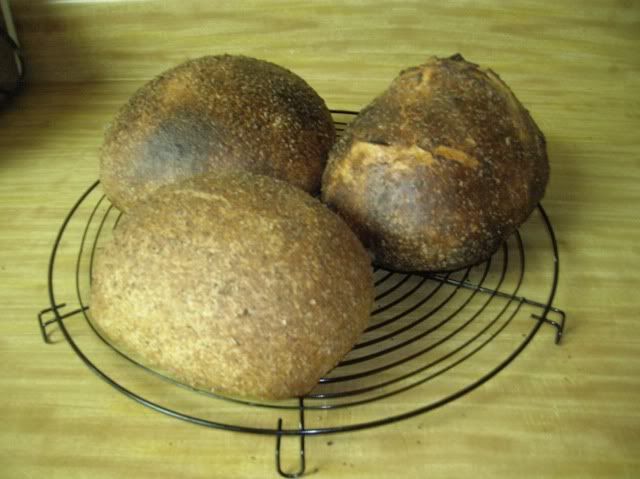
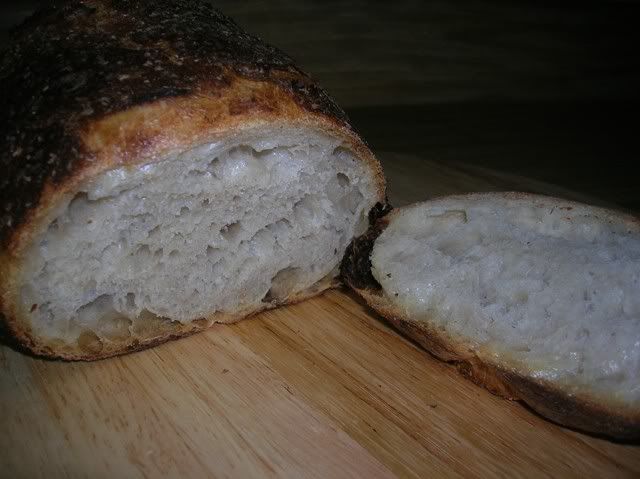
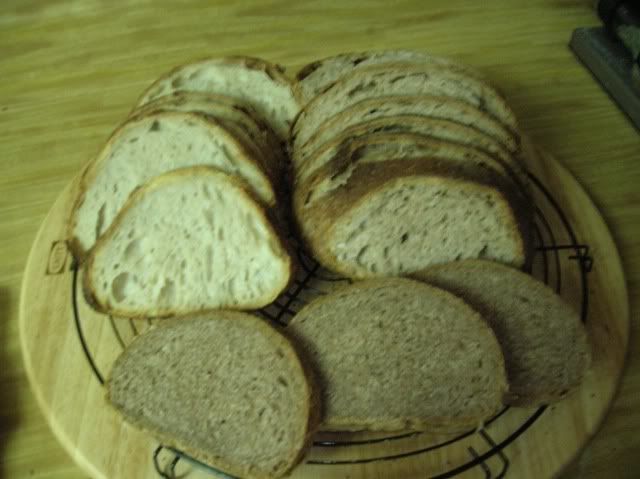
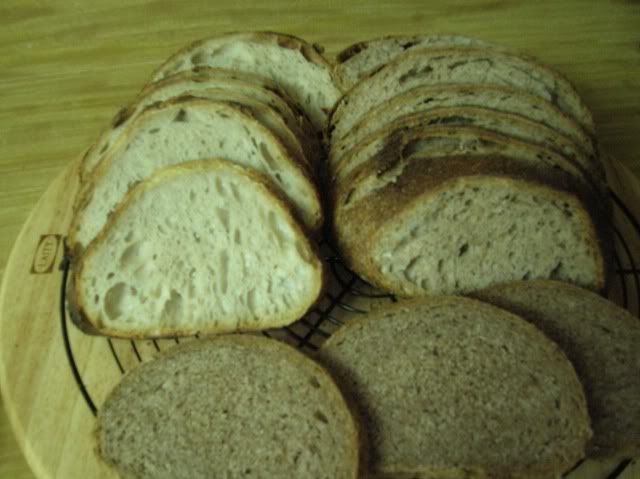

I Made 3 loaves today!
It came out great!
1)first loaf 100% whole wheat
2)second loaf 50% whole wheat ,50% all-purpose flour
3)third loaf 100% all-purpose flour





I took my cold starters, 20g each and added 40g water and 100g low gluten flour and mixed. Kneaded the crumbs into balls and put them into containers and parked then into the 5° (41°F) fridge. My plan is to do a cool rise first to encourage the Lactobacillus and do a warm rise later for the yeast. Also wish to slow down activity for storage. That was Thursday, today is Saturday, about 40 hours have passed and I might have to move the SD balls to larger containers! They leveled out just a little but have almost doubled! This could be interesting! Am I on to something?

Hey all, this is my first time posting on the forum. I just found the site a few days ago and have learned a lot already. I was wondering if anyone had any good recipes for making hoagie rolls. Being very new to the bread-baking scene, I'm not all that good with adapting a standard french or italian loaf into a sub-style loaf. Any guidance would be quite appreciated.
-Ryan

Sourdough Ciabatta - Second Try
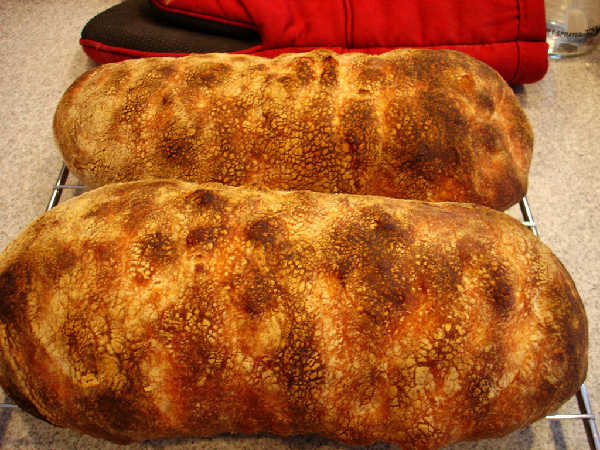 Sourdough Ciabatta - Firm Starter Version (loaves)
Sourdough Ciabatta - Firm Starter Version (loaves)
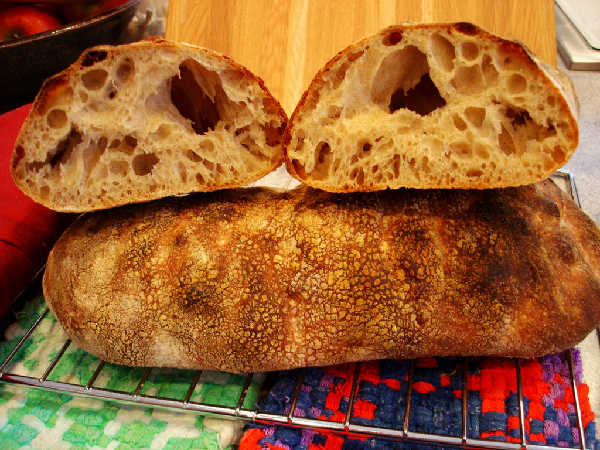 Sourdough Ciabatta - Firm Starter Version (crumb and loaf)
Sourdough Ciabatta - Firm Starter Version (crumb and loaf)
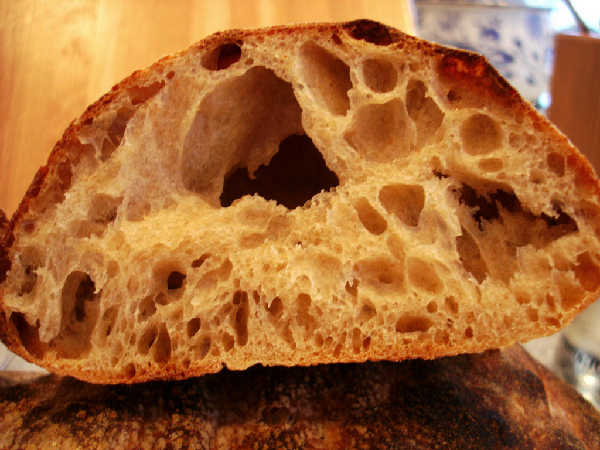 Sourdough Ciabatta - Firm Starter Version (crumb)
Sourdough Ciabatta - Firm Starter Version (crumb)
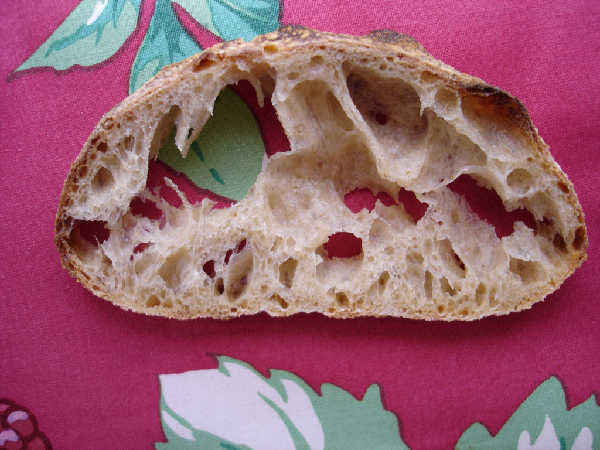 Sourdough Ciabatta - Firm Starter Version (slice)
Sourdough Ciabatta - Firm Starter Version (slice)
Sourdough Ciabatta - Firm Starter Version
One of the favorite family breads seems to be ciabatta, and this sourdough version is clearly preferred (wolfed down) by my kids for its flavor. I've achieved a little better crust and crumb with yeasted versions, particularly the one in Maggie Glezer's "Artisan Baking", but the sourdough flavor is hard to beat, especially with salty grilled left over meats in sandwiches. The recipe is loosely based on the BBA (Reinhart) "Poolish Ciabatta", as well as incorporating ideas from Maggie Glezer's version in "Artisan Baking".
This is a work in progress, but I like the way this one turned out - my second blog entry on this recipe. The flavor is a little mild, which may mean I need to lengthen and/or retard the fermentation, or maybe use somewhat more ripe starter, an exercise for future attempts.
Many thanks to various contributors to this site as always, and especially in this case to Zolablue, who encouraged me to pay more attention to ciabatta with some just great photos and discussions about how to achieve better holes in ciabatta through hydration, proper handling, and flour choice, all of which were used here, (again) after much feedback from my first blog entry on the topic.
This version has been changed to use a lower percentage - around 22% - of flour contributed by the starter, and the starter itself is a firm starter, instead of the usual 100% hydration starter I had been using. My theory here was to try the flavors from the firm starter, as well as lower the percentage of starter in the recipe. The higher percentage seems to cause problems with the texture of the dough before it gets a chance to rise. Zolablue and I have both had good success with a "hybrid" method where some yeast is added to the dough to compensate. However, I was curious to see if I could find a percentage that might work with a pure sourdough raise. The result was a higher rise, but I seem to have made the hydration a little high, as the holes are a little too extreme for my tastes. However that should be solved by simply lowering the hydration on my next try. Also, I ran out of KA AP flour, so I substituted some "sifted red whole wheat flour" from Heartland Mills, which is called "Golden Bufallo". They say it is a "high extraction" flour, i.e. the germ and endosperm is in the flour, but most of the bran has been sifted out. I have found it to be a very good flour for rustic breads. It gives the crumb a darker color and there is a nuttier flavor than with KA. Well, I wish I had just stuck with KA organic AP in this case, as the result was a little more rustic than I had in mind. I suppose there are those who would treasure this result and call it something on the way from white ciabatta to "ciabatta integrale".
Photos of process have been posted for this ciabatta using a firm "recipe starter". Don't worry, you can build this starter from any consistency starter you may have by just setting the hydration to 65%, letting it rise by double and refrigerating overnight. A spreadsheet is also posted showing weights in ounces or grams.
Recipe Starter:
The day before this bread was baked, I took my "BBA style barm", a 100% hydration starter fed with KA Bread Flour, out of the refrigerator. It had been fed within the last couple of days and was fresh and strong at the time it was refrigerated. I mixed the starter with KA Bread Flour and water in the amounts above and kneaded it for a couple of minutes to form a dough. I then put the dough in a container sprayed with a little oil and left it to rise by double - about 4 hours. Once it had risen by double, I refrigerated it to be used the next day in the dough. Note that it is not necessarily a good thing to let the dough rise by more than double or become overly ripe, as it may affect the consistency of the dough the next day.
Dough:
Autolyse:
Mix all flours but 5 oz of AP flour, diastatic malted barley flour, and water together and mix on low speed just enough to get a well mixed batter. Let this sit 20 minutes. I'm trying to simplify the processing relative to the last version by using my mixer for a change.
Mix:
Cut up the starter into small pieces and mix it in along with the salt. Run the mixer for a minute or so to get a good mix of ingredients in what should still be a thick batter consistency. Then, add in the remaining 5 oz of flour as you run the mixer on a low speed. It should turn into a very slack dough after another couple of minutes. I tried to show a picture of it hanging off the mixer dough hook, so check out the photos of the process linked up above.
Bulk Fermentation and Folding: (about 4 hours)
Make a fairly thick bed of flour on the counter about 12 inches square. Using a dough scraper, pour the dough out into the middle of the bed of flour. Allow it to rest for a few minutes. Then, fold the dough by flouring or wetting your hands, then grabbing one side of the dough and lifting and stretching it, folding it over itself like a letter. Do this for all 4 sides. Brush flour off the dough as you fold over the sides that were in contact with the bed of flour. You don't want to incorporate much flour into the dough as you fold. After folding, shape it gently back into a rectangle or square, turn it upside down and push the seams underneath. Place it in a rising bucket or other rising container of your choice. I spray mine with oil to make it easy to remove the dough. I also spray the top of the dough and then dust lightly with flour. Cover the container and allow to rise. Repeat the folds approximately every hour three more times. You just turn it back out on a light bed of flour - you need less flour once the dough is folded a couple of times. Always brush off flour as you fold it to avoid incorporating flour in the dough. If the dough seems very resistant to stretching, only fold it from two directions instead of four. You don't want the dough to get really stiff from too much folding. The amount of folding you will need will be more if you have more water and less if you have less water. Note that even an ounce can make a very big difference in the consistency of the dough. The dough should rise by double over a total of 4 hours. My dough was sitting at about 76F, so you may have to wait a little longer in a cooler room temperature environment. Stop folding if the dough gets too stiff. This means you didn't get as slack a dough as I had here, probably because of less water or maybe because of a different style of flour. No problem, just fold when it is stretchy, but let it rest and rise if not.
This is the first time I used Zolablue's suggestion to put the dough in a container as in Glezer's Artisan Baking, as opposed to doing it on the counter as in the BBA by Reinhart, and as done in my previous blog entry on sourdough ciabatta. I felt it worked well and had a few advantages. First, you can tell easily how much the dough has risen. That's a good thing because the poke test is hard to interpret with this very slack dough. Second, flour doesn't get stuck to the bottom because of the wet dough sitting on the counter in a bed of flour during the rise. I found that the crust was easier to control. Before I was having trouble with big chunks of wet flour paste getting stuck on the dough. I think that can actually look nice and be a characteristic of ciabatta crust, but it seemed to be a little too much that way with the wetter doughs I've been using to make these ciabattas. The last thing is that you can control the bulk fermentation temperature much more easily with the dough in a container that you can move to a good spot for rising.
Shaping:
Divide the dough into four pieces of equal size, roll them in the bed of flour to dust the cut ends, and let them rest a few minutes. To shape, take one of the four pieces, stretch it out and roll it or fold it over itself very gently. With ciabatta this amounts to a gently stretch and fold like a letter. You want to create some tension in the surface of the dough by folding it over itself that way. I sometimes have to roll it up a little more than just a letter fold to give it some tension. Then if you place the dough folds down on a couche, it will seal up the seams. Use the couche to create folds for the ciabatta and then nestle the folds between supports, such as bags of flour or whatever system you may have similar to what you might do for baguettes. I usually also roll the ends underneath a little to get some tension in the ends of the dough.
Final Proof:
Let them rise in the couche for about 1.5 hours, until they are puffy and have increased significantly in volume.
I baked two loaves at a time, so I proofed two loaves for 1.5 hours and two loaves for 2 hours. Da Crumb Bum - you may be right about these SD ciabatta recipes being on the edge of overproofing. I found that the first batch had darker, harder crust, whereas the second was a little bit on the pale side, even though I baked both for the same amount of time in an oven that I know was fully heated and at the same temperature. Also, the oven spring was much better on the first batch. I believe the steam conditions, temperature, and handling were very, very close to identical for both bakes.
Prepare to Bake:
Preheat oven to 500F (yes, you can probably do it without preheating, as mentioned elsewhere on the site, but it's not what I did this time). While that is going on, take each loaf out of the couche, gently stretch it in one direction by about double, lay it on a peel, maybe with parchment paper underneath, maybe sprinkled with corn meal or similar, and use your fingertips to flatten out and dimple the loaf. You can press down fairly firmly to feel the peel underneath. It sounds crazy, but the loaf will bounce back just fine in the oven if it is not overproofed. This step is important to avoid "separation of crust and crumb" or "one gigantic hole" instead of many holes. It also evens out the loaf so it has a nicer shape after baking.
Bake:
Place loaves in the oven and lower temperature to 450F. Bake for about 15 minutes, until the internal temperature is around 209F (I'm near sea level), rotating them after about 9 minutes. You can bake them longer to get a darker, harder crust, or less to get a lighter softer crust. If you bake them in a dry oven for shorter times, you will get a softer crumb and a crispy, thin, lighter crust that is very good if you intend to use these for sandwiches. If you want a chewier, drier bread with a tastier, harder crust, then bake them more and use steam. Then it is a great bread to just dip in olive oil or use like french bread with dinner. The loaves should spring up from their "flattening" with your fingertips, such that not much evidence is left of the dimples you made with your fingers.
The oven spring on these was better than in my first version. The dough also seemed handle more easily. It seemed to stretch without tearing during the folds and didn't seem as sticky. I was happier with the lower percentage of starter in this dough. I wish I had the KA organic AP for the recipe, just for comparison, and also because I liked the soft white crumb, but this one is good for a more rustic effect. The size of these loaves was about 10in x 5in x 2.5in. This is a better oven spring than last time. They were about 3 inches high right after baking, but they shrunk back down to 2.5 inches after cooling off. That's still quite a bit better than the previous version, which was about 2 inches tall. It's probably true that the best of both worlds would be hybrid method, i.e. add about 1/2 to 3/4 tsp of instant yeast to either this recipe or my previous version and get a little bit faster rise and a softer, lighter crumb, as well as getting the sourdough flavors in there.
Cool:
Let bread completely cool, if you can stand to wait.
This bread is especially good for sandwiches, sliced in half and then sliced along the "flat" direction to open up like a hamburger bun. It is great for burgers, steak sandwiches, ham, or just with olive oil and pepper.

Would it be fun to view some miserable failures in this forum? I've been thinking about this as I admire absolutely beautiful baking on this site. I regret that I have let some very entertaining photo subjects get away. For instance, last summer I choked a trout with a pumpernickle. What say?
I'm going to try to capture the best-of-the-worst baking from this day forward. (Wish I'd snapped a pic of that no knead sticking to the towel!)


The best bagels I've ever had were not from New York or New Jersey, or even Philadelphia. They came from a tiny bagel shop in Winston-Salem, NC. I'm not even sure what it's name was; we just called it, "The Bagel Place."
There's no doubt, though, they made the "real thing". Beautifully chewy water bagels with the traditional toppings: plain, poppy seed, garlic, onion, sesame -- and, of course, all the newfangled kinds as well: cinnamon raisin, asiago cheese, chocolate chip, tobacco.
Just kidding about tobacco, of course, though when you live in the hometown of RJ Reynolds Tobacco Corp., the aroma of tobacco tends to permeate the air, especially if a storm is coming in, because the wind changes direction and blows directly over the cigarette factories outside of town.
Tobacco winds or no, the bagels were delicious, and have formed my ideal for what a bagel ought to be. Of course, I may have been a bit biased. I met the baker contra dancing, and he became a good friend: Joe Bagel, we called him. He taught me that bagels should be boiled and then baked good and hot.
I've never had any luck, however, finding a 100% whole wheat bagel that tasted ... good. All the whole wheat bagels I bought had a strong bitter aftertaste, a taste that I now know comes from using whole wheat flour that's less than fresh. And more often than not, they were even more dense than a bagel ought to be.
I've tasted some better whole-wheat bagels recently, but they're not 100% whole wheat. So I decided to see if I could make a decent bagel from fresh whole wheat flour. For inspiration and instruction, I looked to both Reinhart's Bread Baker's Apprentice and Hammelman's Bread. I also thought that sourdough might help - it always seems to do so with everything else. The end result is up above. I'm happy to say tha they were, indeed tasty. In fact, my wife didn't know they were whole wheat until I mentioned it to her after she'd eaten breakfast!
As I'd feared, they were not as chewy as I'd like -- need high-gluten flour for that. I think, perhaps, I'll try adding some vital wheat gluten the next time around to see if I can increase the chew factor. Anyway, here's how I made them:
Overall formula

Many recipes for loaf bread that use milk advise that the milk must first be scalded (brought just to the boil). (Then, of course, you have to wait for the milk to cool.) I remember reading an explanation that something in the milk can inhibit yeast growth and the heat somehow corrects this.
Tell me, gurus, is it really necessary to scald the milk? If yes, why? If no, why not (can it just be a holdover from earlier times that has been mindlessly perpetuated)?
PS - I love long, involved scientific explanations, so please feel free to elaborate
Thanks in advance...
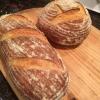
Can someone help me with formulating a recipe for making a 100% whole wheat sourdough? I do not want to make a bread with white flour, and prefer not to use milk, eggs etc. I made a few loaves using a starter, flour, salt and water. Can I do the same with whole wheat?
I bought a box of vital gluten, should I use that to get better results in my wheats?

Hi,
OK this is probably a total newbie question but here goes...
It seems like many of you bake mostly or exclusively with sourdough. I am wondering, is there some kind of basic 'general rule' about using wild yeast instead of commercial yeast in non SD recipes? Or if not, I would love to get some experienced opinions on the best way to do this.
I do know that the fermentaton times in commerical yeast are pretty standard - and I am learning, at least with what little experience I've had with my sourdough starter so far that the fermenation times are a lot longer.
I was thinking that a good start would be to replace the 'sponge' or 'poolish' that is called for in a lot of commerical year recipes with the same amount of starter - (and of course omit any yeast that is called for anywhere else in the recipe).
Will this work?
I would love comments, suggestions, thoughts, and any input anyone has on this subject.
thanks!

Sourdough Raisin Focaccia
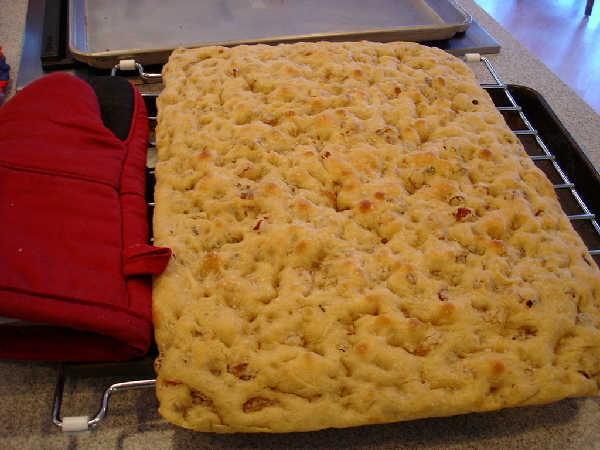 Sourdough Focaccia
Sourdough Focaccia
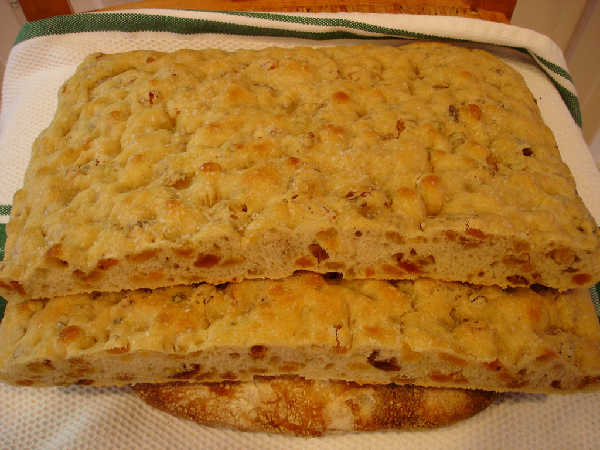 Sourdough Raisin Focaccia (a)
Sourdough Raisin Focaccia (a)
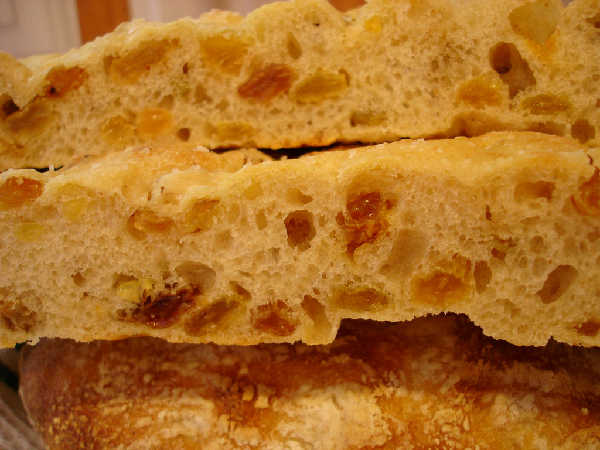 Sourdough Focaccia Crumb
Sourdough Focaccia Crumb
My wife's favorite bread is without a doubt sourdough raisin focaccia. The recipe is loosely based on the BBA (Reinhart) "Poolish Focaccia", including his mention of raisin focaccia and a tradition in certain parts of Italy for "breakfast focaccias".
Many thanks to various contributors to this site as always. Photos of the process have been posted for this sourdough raisin focaccia and the sourdough ciabatta I made at the same time and mentioned recently in a previous blog entry. A spreadsheet is also posted showing weights in ounces or grams.
Starter:
The day before this bread was baked, I took my "BBA style barm", a 100% hydration starter fed with KA Bread Flour, out of the refrigerator. I fed it 1:2:2 (starter:flour:water) three times over the course of the day at room temperature, which refreshed the starter and built enough starter for this recipe, the sourdough ciabatta I also made the next day, as well as some left over to return to storage in the refrigerator. The larger amounts were made by feeding with KA organic AP flour, to convert to KA organic AP flour, a choice of a slightly lower protein flour that should be good for irregular, large holes and artisan style bread.
Dough:
Autolyse:
Mix the flours and water together in a bowl (I used a dough hook for this). Let sit for about 30 minutes.
Mix:
Mix flours and water above with the 14 oz of starter, 0.5 oz salt, 2.5 oz olive oil, and mix for a couple of minutes - just long enough to thoroughly mix the starter and salt with the flour and water from the autolyse step. Add a box of golden raisins (about 2.5 cups). The dough should be quite "wet", meaning it will not clean the bottom or even much of the sides of the mixer bowl. It should be fairly sticky and already have a fair amount of gluten development. I realize I needed a little more water than I actually used (10 oz), so the recipe says 10.5 oz and is what I will use next time. As a result, the dough was a little too stiff and the crumb wasn't quite as open as I think it would be with the extra ounce of water.
Bulk Fermentation and Folding:
Make a fairly thick bed of flour on the counter about 12 inches square. Using a dough scraper, pour the dough out into the middle of the bed of flour. Allow it to rest for a few minutes. Then, fold the dough by flouring or wetting your hands, then grabbing one side of the dough and lifting and stretching it, folding it over itself like a letter. Do this for all 4 sides. Brush flour off the dough as you fold over the sides that were in contact with the bed of flour. You don't want to incorporate much flour into the dough as you fold. After folding, shape it gently back into a rectangle or square, spray it with a light coating of olive oil or some other oil spray, and dust very lightly with flour. Then cover it with plastic wrap, and drop a towel over it. If the dough seems a little stiff at this point, it unfortunately probably already doesn't have enough water in it. You can put it back in the mixer and add 1 oz of water and try again. Or, soldier on and adjust your water next time. Repeat the folds approximately every 45 minutes two more times. If the dough seems very resistant to stretching, only fold it from two directions instead of four. You don't want the dough to get really stiff from too much folding. The amount of folding you will need will be more if you have more water and less if you have less water. Note that even an ounce can make a very big difference in the consistency of the dough. After three folds, let the dough rise for another 1.5 to 2 hours, at which point, the dough should have doubled roughly in volume. Use the "poke test" to get a feel for how long to continue the bulk fermentation.
Shaping:
Line a standard (the ones that are about 17 inches long and 13 inches wide) baking sheet with parchment paper and spread about 1/4 cup of olive oil over the parchment paper. Transfer the dough to the sheet. Spread the dough out by dimpling it systematically with your finger tips, pressing down firmly into the dough with all ten fingertips, and slowly getting the dough to spread out in the pan. Don't stretch the dough, just dimple it by pressing into the dough vertically with your fingers. If necessary, wait 10 minutes for the gluten to relax, if it won't spread out enough to fill the pan at first. As you do the dimpling with your fingers, work about another 1/3 cup of olive oil into the top of the dough by spreading it over the top of the dough as you dimple away. Once the dough has spread all the way out and nearly fills the corners, you can cover it with saran wrap.
Final Proof:
Let the dough rise for about 2.5 hours, until it is puffy and has increased significantly in volume. With this sourdough version it may not rise above the lip of the pan, but it should come close. If it rises unevenly, you can dimple the high sections again periodically to even out the height of the dough across the whole pan. I actually let this one rise almost 3 hours. It finally seemed to relax and rise around 2.5 hours, so I went ahead and tried baking it. As I mentioned before, the result wasn't quite as open of a crumb as I hoped, but it was fine - next time a little more water, and it will be better.
Prepare to Bake:
Preheat oven to 500F. Remove plastic wrap, and use your fingers to spread about 3/4 teaspoon of kosher salt evenly over the dough. Don't use more than 3/4 tsp of salt, or it will come out too salty. Spread the salt with your fingers by holding the 3/4 tsp of salt in your palm and picking up pinches of salt and slowly spreading it over the dough. Again, it's important to get it spread evenly in just the right amount, and that is very difficult to do unless you measure out 3/4 tsp of kosher salt and then spread it in small pinches very evenly over the whole surface.
Bake:
Place pan in the oven and lower temperature to 450F. Bake for about 12 minutes, until the internal temperature is around 207F (I'm near sea level), rotating it after about 9 minutes. You can bake longer to get a darker, harder crust. Actually, I think this KA organic artisan AP flour may benefit from a little bit of added diastatic malted barley flour, as the breads I baked with this flour today were more pale than previous results with KA AP or KA Bread Flour combinations. I don't think I overproofed them, but maybe that's a factor. The focaccia should spring up from their "flattening" with your fingertips, such that not much evidence is left of the dimples you made with your fingers.
Cool:
Let bread completely cool, if you can stand to wait.
This bread is especially good for breakfast lightly toasted or heated with a little butter and/or honey. The mixture of salt, sourdough flavor, and the sweetness of the raisins is delicious.